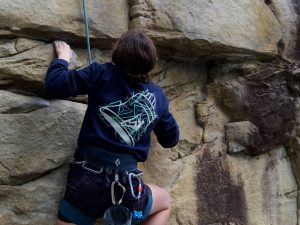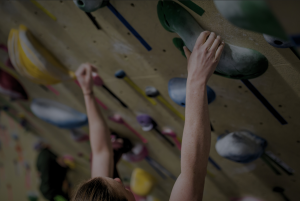Refined Core Skill
Exaggerated weight shifting is considered a refined core skill. Because of the problems with relying on “feel” at steeper angles, climbers need to be almost over-focused on weight shifting, all for front-stepping, twist locks, and flagging.
Front-Stepping
In front-stepping, climbers have a tendency to short the swing. This simply means they fail to get their hips far enough left or right to truly be over their heel. Another prevalent problem climbers face is that often fail to arch their back fully to get their hips into the wall.
The key points to remember is that the closer your hips are to the wall when you push up, the more force is directed along the wall (rather than away from it). Remember that being off your heel even by an inch will push you away from the hold you are aiming for.
Back-Steps
For twist locks the same applies. But, in addition, a few other issues frequently arise.
While it has been mentioned before, on steeper angles the “spin out” is more common and more taxing than on vertical terrain. As a reminder, a spin out occurs when a climber uses a foothold for the motion point which is “behind the line” i.e., one which is behind the handhold they are pulling off of.
It is physically nearly impossible for a climber to hold the lower body lock when twisting into the wall on such a foot. As a result, when back-stepping off of such a hold, climbers must use much more arm strength to hold the lock. This effectively wastes energy.
It is therefore quite critical to choose appropriate feet for back-steps. Footholds that are behind the line generally require an oppositional foot and should be turned into drop knees.
Flagging
Flagging, too, becomes much more critical. In particular, climbers must aim to keep the flagging leg straight and focus on maintaining balance throughout the move.
In combination with deadpointing, climbers should also use the flagging leg to help generate momentum, essentially using the flagging leg as a lever to help “throw” their hips off up the wall toward the next handhold.
This is accomplished by relaxing the hip muscles (but not the knee!) and allowing the flagging leg to drop as the hips move up.
This last skill is one that seems particularly difficult for newer climbers to master. Their tendency is to hold the flagging leg in the starting position throughout a move. Developing the proper swing to that leg, however, is critical for saving energy and generating upward momentum.
In all cases though the flagging leg should remain close to the wall. Climbers should avoid allowing the leg to drift outward, as this creates a dead weight that pulls their hips away from the wall.
All material is reprinted with the permission of the author. Copyright 2022 David H. Rowland. All rights reserved.









